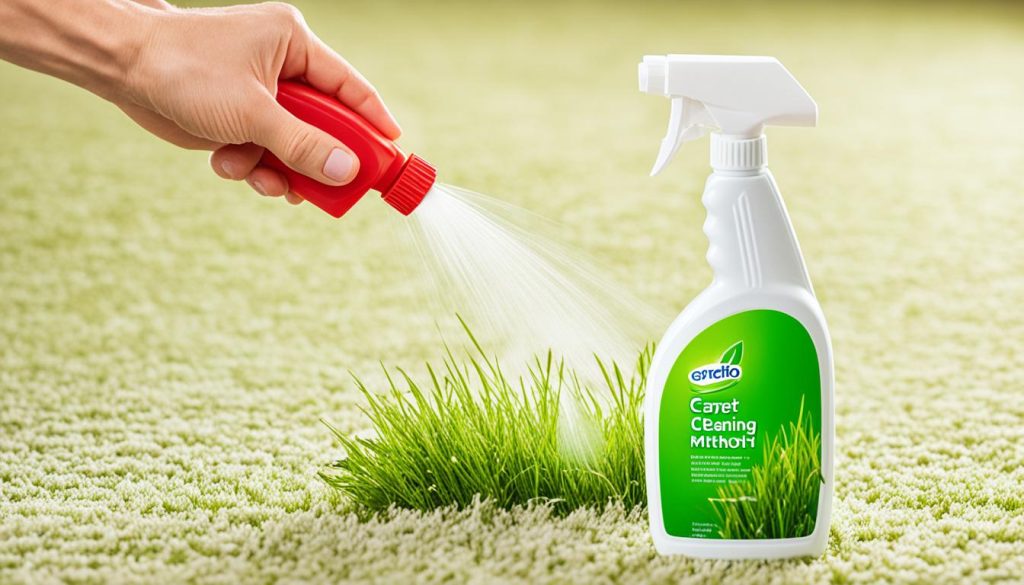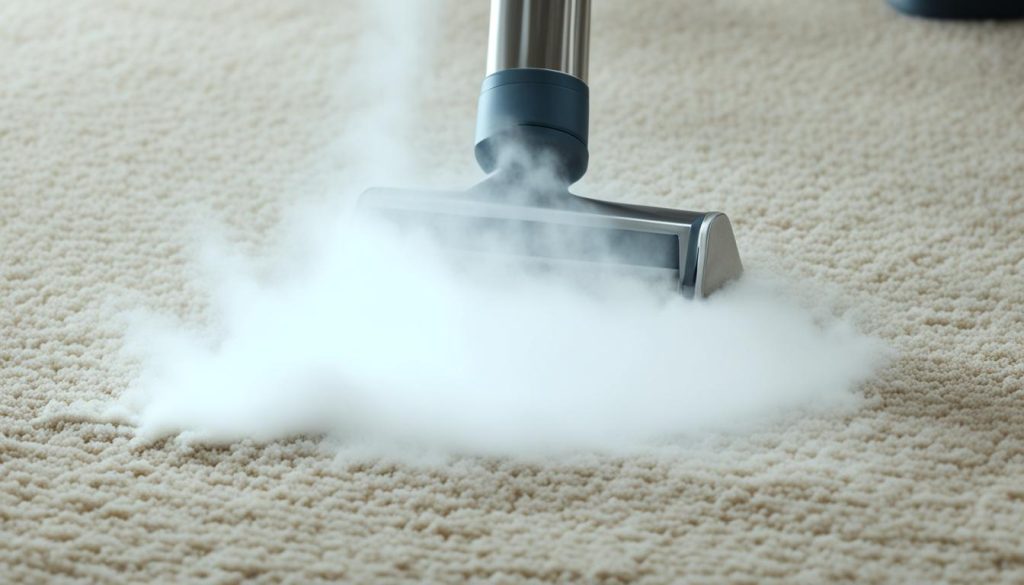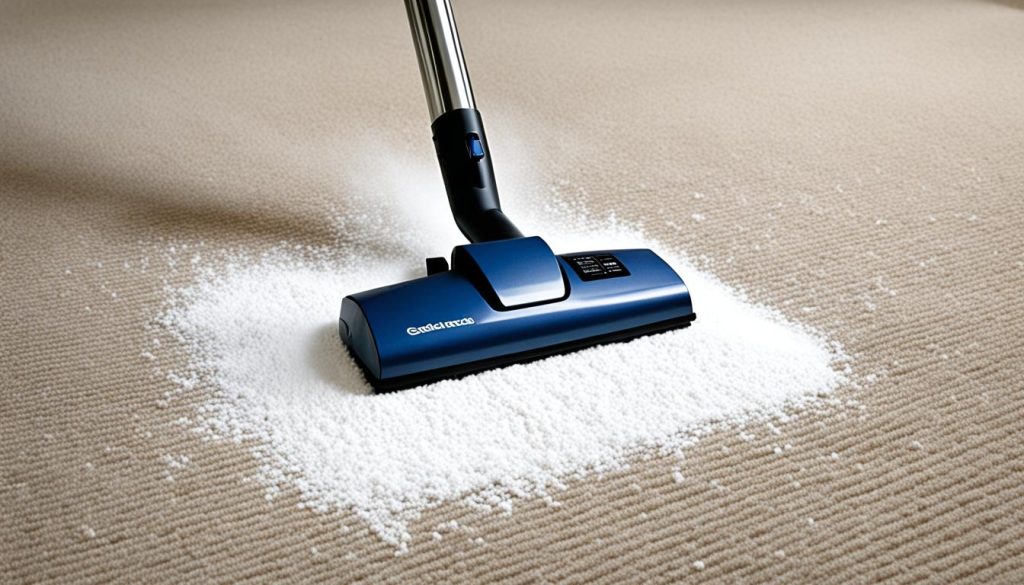When it comes to maintaining a clean and fresh-smelling home, baking soda is a go-to solution for many. However, accidents happen, and you might find yourself with a tricky baking soda stain on your carpet. Whether from a spill or a deodorization attempt gone wrong, knowing how to remove baking soda from carpet is essential. In this guide, we’ll provide you with the best carpet stain removal practices and a cleaning solution for baking soda stains to ensure your carpets stay in pristine condition.
Key Takeaways
- Understanding the nature of baking soda residues is crucial for efficient stain removal.
- Proper vacuuming is a vital first step in the cleaning process.
- Vinegar solutions offer a natural and effective technique for tackling carpet stains.
- Steam cleaning can elevate stain removal to a professional level.
- Lemon juice is a powerful citric-based alternative for those looking for natural solutions.
- Preventing baking soda stains requires cautious application and immediate action in case of spills.
Understanding Baking Soda Stains on Carpets
When it comes to maintaining your carpet’s cleanliness and longevity, understanding the specifics of baking soda residue is crucial. Baking soda can be a double-edged sword; it’s often used as a deodorizing agent due to its ability to neutralize odors. However, the fine granular nature of baking soda can lead to challenging stains that embed deeply within carpet fibers.
Carpet cleaning methods are varied, but not all are suitable for tackling the problem of baking soda stains. While some might suggest a simple brush-off, this approach may prove ineffective, potentially pushing the powder deeper into the carpet. Professional insight reveals the importance of vacuuming baking soda from carpets before employing any wet cleaning techniques. This process helps prevent the baking soda from forming a paste-like residue when it comes into contact with moisture, which is significantly harder to remove.
Baking soda is inherently absorbent, which is why it is so effective at soaking up undesirable scents. Yet, this property also means that it absorbs any liquid solutions used during the cleaning process. Thus, without preemptive vacuuming, you risk creating more tenacious stains.
| Challenge | Vacuuming | Alternative Cleaning Methods |
|---|---|---|
| Deeply embedded grains | Thorough vacuuming often with a brush attachment | Steam cleaning or professional treatment |
| Paste-like residue post-moisture contact | Pre-cleaning vacuum to remove loose particles | Gentle blotting and specific spot treatment |
| Sticky residue from previous cleaning attempts | Power vacuuming to lift residual baking soda | Chemical cleaners with caution to prevent damage |
Encountering baking soda residue during your regular carpet maintenance can be a nuisance. However, employing the recommended carpet cleaning methods and completing these with a comprehensive vacuuming session can ensure that your efforts in maintaining a fresh and clean carpet are successful.
The Vinegar Solution: A Step-by-Step Guide for Stain Removal
Utilizing a vinegar solution for baking soda stains is a tried-and-true method favored by many homeowners. This accessible and natural approach to carpet care provides a DIY stain removal option beyond the use of harsh chemicals. Not only is vinegar effective in combatting tough stains, but it also contributes to natural carpet cleaning practices that are safer for your home and the environment. Below, you will find a comprehensive guide to using vinegar to restore the beauty and cleanliness of your carpets.
Creating the Vinegar Mixture
To start, you will need to prepare the vinegar cleaning solution. The mixture is simple: Combine equal parts of white vinegar and warm water to create an effective cleaning agent. The exact quantities will depend on the size of the stain; however, one cup of each is usually sufficient for a standard stain. White vinegar is preferable due to its cleanliness and neutral color, which ensures no additional stains are left behind.
Applying the Solution to Stains
Before applying the mixture, be sure to test a small, inconspicuous area for colorfastness. Once confirmed, gently blot the baking soda stain with the vinegar solution using a clean, white cloth or sponge. Avoid scrubbing, as this can embed the stain further into the carpet fibers. Instead, pat the moistened cloth onto the affected area, allowing the vinegar to dissolve and lift the stain. For stubborn stains, a soft-bristled brush can be used to lightly agitate the fibers.

Drying and Rinsing for a Spotless Carpet
After applying the vinegar solution, it is pivotal to remove any residual moisture and cleaning agent. Start by blotting the area with a dry towel to absorb as much dampness as possible. Follow this with a rinse using clean, cold water to ensure all vinegar is removed from the carpet. Finally, blot dry once more with a fresh towel or cloth. For quicker drying, you can employ fans or open windows, which will help ventilate the area and expedite the process. A properly dried carpet not only looks cleaner but also helps prevent mold and mildew growth.
Employing a vinegar solution for baking soda stains not only serves as an effective DIY stain removal method but also underscores the appeal and practicality of natural carpet cleaning techniques. These simple steps can help maintain your carpet’s pristine condition while also supporting a healthier living environment.
How to Get Baking Soda Out of Carpet Using Steam Cleaning
When it comes to steam cleaning for baking soda stains, the process is recognized for its effectiveness and depth of clean. Steam cleaners use heat and pressure to penetrate carpet fibers, breaking down the baking soda and eliminating the stain, which can be particularly beneficial for those stubborn spots where traditional methods have faltered.
Rental steam cleaners offer a feasible solution for homeowners wanting to tackle the issue themselves without the long-term commitment of purchasing equipment. These units are available at many home improvement stores and typically come with instructions to ensure proper usage.
However, for individuals looking for a hassle-free experience, hiring a professional carpet cleaning service may be the optimal route. Experts come equipped with industrial-strength steam cleaners that offer a higher level of cleanliness, applying their expertise to effectively remove baking soda stains and revitalize your carpet.

Whether you choose the DIY route with a rental or opt for the easy route with a professional service, here’s a simple breakdown of the steps involved in the steam cleaning process:
- Preparation: Clear the area and vacuum the carpet to remove any loose debris.
- Equipment setup: Assemble the steam cleaner, fill it with water, and if needed, add the recommended cleaning solution.
- Steam application: Move the steam cleaner over the carpet, allowing the heat and moisture to dislodge the baking soda.
- Drying: Allow your carpet to dry thoroughly, which may take several hours, to prevent any mildew or water damage.
Steam cleaning your carpet not only removes the visible marks but also sanitizes the area, killing bacteria and allergens that may be lurking beneath the surface. Therefore, whether you hire a professional carpet cleaning service or use a rental steam cleaner, you’re ensuring a deep clean that goes beyond just aesthetic appeal.
Leverage the Natural Cleaning Power of Lemon Juice
When tackling the stubborn issue of baking soda stains on your carpet, you might find a surprising ally in your kitchen: lemon juice. Known for its effective natural cleaning attributes, lemon juice for baking soda stains works wonders thanks to citric acid, an organic compound known for its stain removal properties. This humble fruit’s juice not only combats tough stains but also imparts a fresh, clean scent to your living space, making it a favorable choice among natural carpet cleaning solutions.
Creating the optimal lemon juice solution for your carpet involves diluting it with water to ensure the carpet fibers are not overwhelmed by the acidity. A mixture ratio of one part lemon juice to two parts water is typically effective. To utilize this solution, apply it directly to the baking soda stains, using a clean cloth or sponge to gently work it into the fibers. After allowing the solution to sit for a few minutes, blot the area with a dry towel to absorb the lemon juice mixture along with the lifted stain.
The final phase in restoring your carpet’s pristine state is the drying process. Proper drying is essential, as lingering moisture can lead to mold or mildew formation. It is also prudent to avoid exposing the treated areas to direct sunlight during this stage because the sun’s UV rays can cause color fading, especially in darker carpets. By following these gracious steps, your carpet will not only be freed of baking soda residues but also be infused with a zestful cleanliness only nature can provide.


